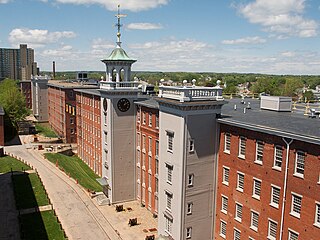
Lowell National Historical Park is a National Historical Park of the United States located in Lowell, Massachusetts. Established in 1978 a few years after Lowell Heritage State Park, it is operated by the National Park Service and comprises a group of different sites in and around the city of Lowell related to the era of textile manufacturing in the city during the Industrial Revolution. In 2019, the park was included as Massachusetts' representative in the America the Beautiful Quarters series.

Yandina is a town and locality in the Sunshine Coast Region, in the Australian state of Queensland.

Naihati is a city and municipality of North 24 Parganas district in the Indian state of West Bengal. It is a part of the area covered by Kolkata Metropolitan Development Authority (KMDA).
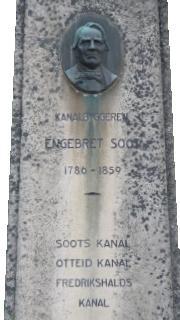
The Halden Canal near Halden, Norway, began construction in 1852. The canal allows boats to travel parallel to the Swedish border of 75 km from Tistedal to Skulerud. Engebret Soot was responsible for this canal, as well as the earlier Soot Canal. Tistedal is located 4 km from the sea at Halden. Boats can be transported by road here and from Ørje to Dalsland Canal. Halden Canal was added to the list of priority technical and industrial cultural heritage by the Norwegian Directorate for Cultural Heritage.

Karjohansvern at Horten was the main base for the Royal Norwegian Navy from 1850 to 1963.

Birlapur is a census town within the jurisdiction of the Budge Budge police station in the Budge Budge I CD block in the Alipore Sadar subdivision of the South 24 Parganas district in the Indian state of West Bengal.

Lawrence Heritage State Park is a history-themed public recreation area dedicated to preserving the industrial heritage of Lawrence, Massachusetts. The state park comprises three separate units on or near the Merrimack River. It is managed by the Massachusetts Department of Conservation and Recreation.

The Ministry of National Defense is a government ministry office of the Republic of Turkey, responsible for coordinating and supervising all agencies and functions of the government concerned directly with national security and the Turkish Armed Forces. It is headquartered at the Bakanlıklar in Ankara.

The Kistefos Wood Pulp Mill is a former pulp mill and hydroelectric power plant in Jevnaker, Norway. It was founded by Kistefos at the river Randselva in 1889.

The Directorate for Cultural Heritage is a government agency responsible for the management of cultural heritage in Norway. Subordinate to the Norwegian Ministry of the Environment, it manages the Cultural Heritage Act of June 9, 1978. The directorate also has responsibilities under the Norwegian Planning and Building Law.

Harry Fett was a Norwegian art historian and factory owner. He headed the Norwegian Directorate for Cultural Heritage from 1913 to 1946.

The Naval Sea Systems Command (NAVSEA) is the largest of the United States Navy's five "systems commands," or materiel organizations. From a physical perspective, NAVSEA has four shipyards for shipbuilding, conversion, and repair, ten "warfare centers", the NAVSEA headquarters, located at the Washington Navy Yard, in Washington D.C., and other locations in 15 states and 3 overseas continents.

The Norwegian Sawmill Museum is a museum located in the village of Spillum in Namsos Municipality in Trøndelag county, Norway. The town of Namsos lies just to the north, across the river Namsen. The museum opened in 1991 at the site of the former sawmill operated by Spillum Sawmill & Planing.
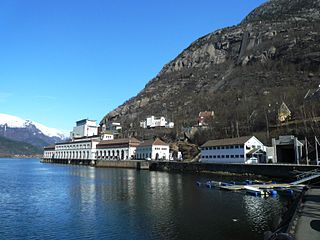
The Tyssedal Power Station is a hydroelectric power station and museum located in Tyssedal in the municipality Odda in Vestland, Norway. The station was designed by architect Thorvald Astrup. It started production in 1906 and operated at a combined installed capacity of 100 MW from 1918, with an average annual production of 700 GWh. The plant was protected by the Norwegian Directorate for Cultural Heritage in 2000, and is part of the Norwegian Museum of Hydropower and Industry. The power station was added to the list of priority technical and industrial cultural heritage by the Norwegian Directorate for Cultural Heritage.
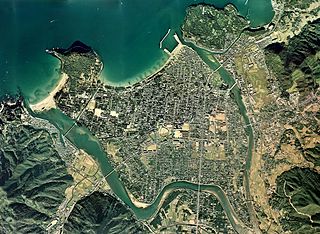
Sites of Japan's Meiji Industrial Revolution: Iron and Steel, Shipbuilding and Coal Mining are a group of historic sites that played an important part in the industrialization of Japan in the Bakumatsu and Meiji periods, and are part of the industrial heritage of Japan. In 2009 the monuments were submitted jointly for inscription on the UNESCO World Heritage List under criteria ii, iii, and iv. The sites were accepted at the 39th UNESCO World Heritage session.
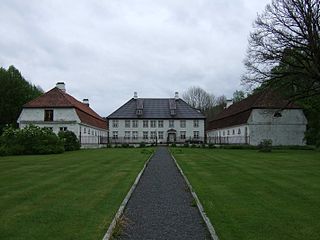
Næs Ironworks in Holt, was an iron works which started operation in 1665 under the name “Baaseland Værk”. The blast furnace and foundry were located at the Båsland farm, while the associated forge was located a kilometer further east, by the Storelva river at Næs. The blast furnace was new, and not an extension of the Barbu jernverk at Arendal which ceased operations in the 1650s. “Baaseland Værk” was given the name Naes blast furnace operation when the buildings were concentrated by Storelva in 1738. About 1840 the firm was renamed Jacob Aall & Søn. It ceased operation in 1959.

The Campolmi Factory, the Prato textile museum and Lazzerini Library is a textile museum and library in Prato in Tuscany, Italy. The museum is an Anchor point on the European Route of Industrial Heritage.

The Neptune Herring Oil Factory is a former industry in the town of Melbu in Norway's Vesterålen district. It has been given cultural heritage status.

The Atlungstad Distillery is a distillery in Stange in Hedmark county, Norway. It was established in 1855 by a group of farmers. Regular distillation was discontinued in 2000, but trial runs were later carried out. In 2012, the distillery was added to the Norwegian Directorate for Cultural Heritage list of priority technical and industrial cultural heritage, after which NOK 7 million was allocated to restore the distillery to its former condition. An additional NOK 4.7 million was allocated for the distillery in 2017. It has been owned by the company Atlungstad Brenneri AS since 2011. In October 2013, the owners signed a cooperation agreement with the Arcus company that they would restart regular production of akvavit at the Atlungstad Distillery. The distillery is open for tours in the summer.
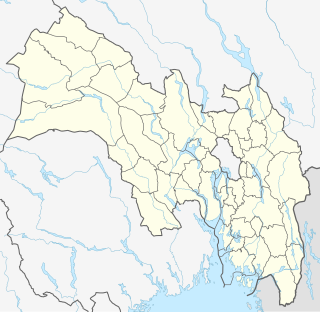
The Kistefos Museum is a contemporary art museum and sculpture park located in Jevnaker, Norway. The art park first opened to the public in 1996 with an exhibition of 25 sculptures. Founded by Christen Sveaas, the biggest shareholder of Kistefos, a privately owned investment company, the museum sits on the site of a disused wood pulp mill and includes the Kistefossen waterfall. The 17.6-hectare art park runs around the Randselva river and the surrounding areas, including old factory buildings such as the pulp mill and other buildings leased by the Kistefos group. With donations from the Jevnaker municipality and Christen Sveaas, Kistefos holds two art galleries, a museum, and a sculpture park currently containing 46 sculptures, by both Norwegian and international artists. Kistefos Museum was listed as one of ten technical and industrial cultural heritage sites by the Norwegian Directorate for Cultural Heritage, acting as a modern, industrial monument worth preserving as part of Norwegian and Scandinavian culture.






















